The Kuwaiti dinar (KWD) is the official currency of Kuwait, and it is one of the most valuable currencies in the world. As of January 2024, one Kuwaiti dinar is worth approximately 3.25 US dollars, making it the highest-valued currency per unit.
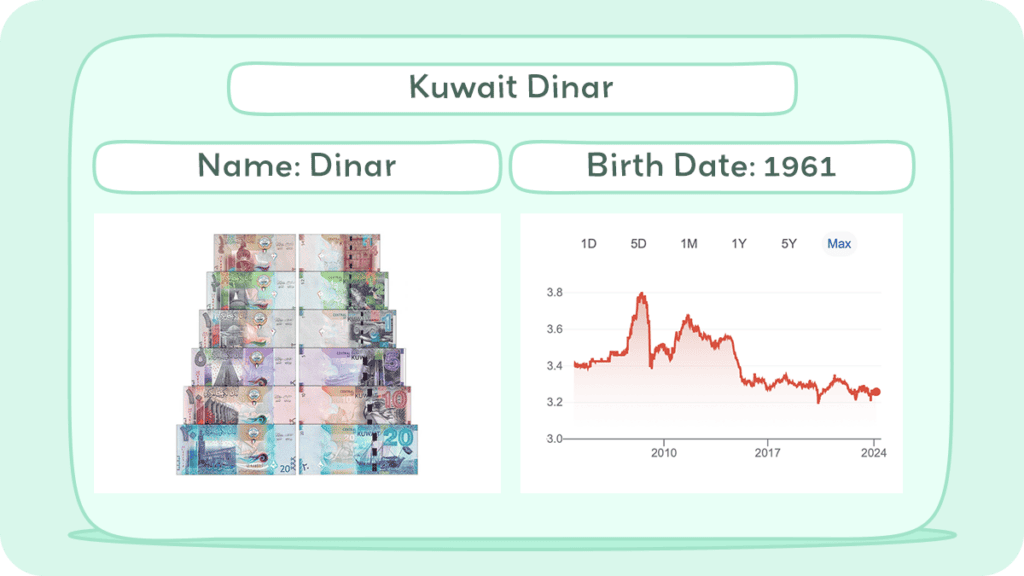
The Kuwaiti dinar has a long and interesting history. It was first introduced in 1961, replacing the Gulf rupee, which was the currency used in the region prior to Kuwait’s independence.
Today, the Kuwaiti dinar is pegged to an undisclosed basket of currencies, most likely including the US dollar.
This article explores the Kuwaiti dinar, Kuwait’s official currency. It covers its history from before Kuwait’s independence to its position as one of the strongest currencies globally.
Historical Journey of Kuwait Currency
Kuwaiti dinar (KWD) is the national currency of the State of Kuwait. The dinar was introduced in 1961 to replace the Gulf rupee, which was equal to the Indian rupee. Initially, the Kuwaiti dinar was equivalent to £1 sterling.
In 1975, the Kuwaiti dinar became the world’s most valuable currency. It was worth more than the British pound, US dollar, and Swiss franc. The dinar’s value was pegged to a basket of currencies, including the US dollar, the British pound, and the Japanese yen.
During the Gulf War in 1991, Iraq invaded Kuwait and occupied the country for several months. After Iraq was expelled from Kuwait, the banks revalued their currency to $3.47, making the Kuwaiti dinar the highest valued currency in the world at that time.
Today, the Kuwaiti dinar remains one of the world’s most valuable currencies. As of 2024, one Kuwaiti dinar is equal to $3.29 USD. The dinar is made up of 1000 fils, and it is often presented with the symbol د.ك.
Over the years, the Kuwaiti government has taken steps to maintain the stability of the dinar. For example, the Central Bank of Kuwait regularly intervenes in the foreign exchange market to stabilize the dinar’s value against other currencies.
Additionally, the government has established a sovereign wealth fund that invests in foreign assets to diversify the country’s sources of revenue.
The Kuwaiti dinar has a fascinating historical journey, from its introduction in 1961 to its current status as one of the world’s most valuable currencies. The dinar’s stability and high value have made it an attractive currency for investors and traders around the world.
History of Coins
In 1961, Kuwait introduced the dinar to replace the Gulf rupee, initially setting its value equal to £1 sterling. This led to a conversion rate of ₹13+1⁄3 to 1 Kuwaiti dinar. However, during the 1990 Iraqi invasion of Kuwait, the Iraqi dinar temporarily replaced the Kuwaiti dinar, and many Kuwaiti banknotes were stolen.
Post-liberation, Kuwait reinstated the Kuwaiti dinar and introduced new banknotes, rendering the old ones, including those stolen, obsolete. The coins minted since 1961 have a consistent design featuring a boom ship on the obverse and the value in Arabic on the reverse.
Unique among Middle Eastern currencies, Kuwait includes a coin valued at 0.02 of its main unit, with higher denominations available as banknotes. The production of the 1 fils coin ceased in 2014.
History of Bills
The Kuwaiti dinar has undergone significant changes through its banknote series since its inception. The journey began with the first series introduced in 1961, following the establishment of the Kuwaiti Currency Law.
This series, which included denominations from KD 1⁄4 to KD 10, circulated until 1982. The second series emerged after the Central Bank of Kuwait was established in 1969, featuring updated designs for similar denominations, and it too was withdrawn in 1982.
The third series, released in 1980 and expanded in 1986 with a KD 20 note, was later invalidated due to the Iraqi invasion of Kuwait in 1990, which led to significant thefts of these banknotes.
Following Kuwait’s liberation, the fourth series was introduced in 1991, aiming for a rapid economic recovery. This series continued in circulation until 1995. The fifth series, launched in 1994, incorporated advanced security features and remained in use until 2015.
It showcased Kuwait’s cultural heritage and included denominations identical to the fourth series. In 2014, the sixth and current series was introduced, notable for its tactile features to aid the visually impaired. These notes feature distinctive designs and colors, celebrating Kuwaiti landmarks and culture.
In addition to these regular issues, the Central Bank of Kuwait also released commemorative KD 1 polymer notes in 1993 and 2001 to mark Kuwait’s liberation from Iraq. These notes, rich in national symbolism and security features, were intended for commemoration rather than as legal tender.
The Kuwaiti dinar’s evolution reflects the nation’s historical milestones and its commitment to incorporating modern security and accessibility features in its currency.
Inflation and Buying Power of Kuwaiti Dinar
The Kuwaiti dinar (KD) is one of the most valuable currencies in the world, with a strong purchasing power. This is due to the country’s vast oil reserves, which have helped to create a stable and prosperous economy.
Inflation rates in Kuwait have been relatively stable over the past few years, with an average rate of around 2.5% between 2019 and 2023. According to World Data, over the last 49 years, Kuwait’s inflation rate varied from -0.5% to 13.0%.
In 2022, the inflation rate was 4.0%. From 1973 to 2022, the average annual inflation rate was about 4.1%. This led to a total price increase of 592.93%, meaning an item that cost 100 dinars in 1973 would cost 692.93 dinars in early 2023.
Despite the fluctuations in inflation rates, the buying power of the Kuwaiti dinar has remained strong. This means that you can purchase more goods and services with one Kuwaiti dinar than you can with many other currencies.
In January 2024, the average price of a liter of gasoline in Kuwait was around 0.08 KD, which is equivalent to approximately 0.26 USD. In comparison, the average price of a liter of gasoline in the United States was around 0.71 USD, which is more than double the price in Kuwait.
The Kuwaiti dinar is a valuable and stable currency that provides strong buying power to its users. While inflation rates may fluctuate, the country’s strong economy and vast oil reserves help to maintain the purchasing power of the currency.
Kuwaiti Dinar
The sixth series of Kuwaiti banknotes, issued on June 29, 2014, features distinct designs and colors for each denomination.
KD 1⁄4
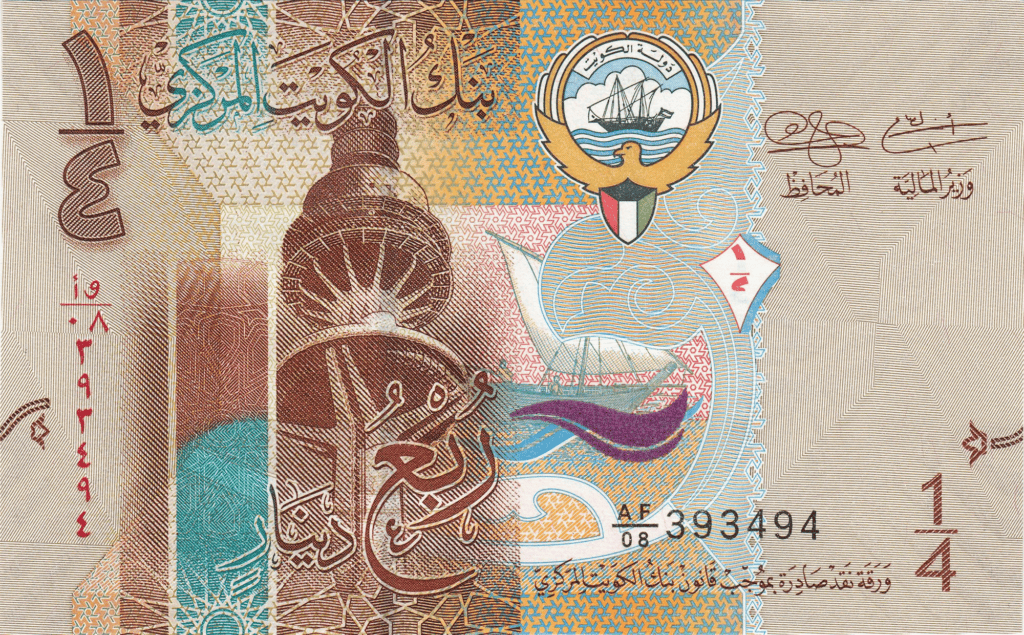
The KD 1⁄4 note depicts the Liberation Tower and a dhow ship on the front, and a traditional Kuwaiti door and the first Kuwaiti coin on the back, in a brown color.
KD 1⁄2
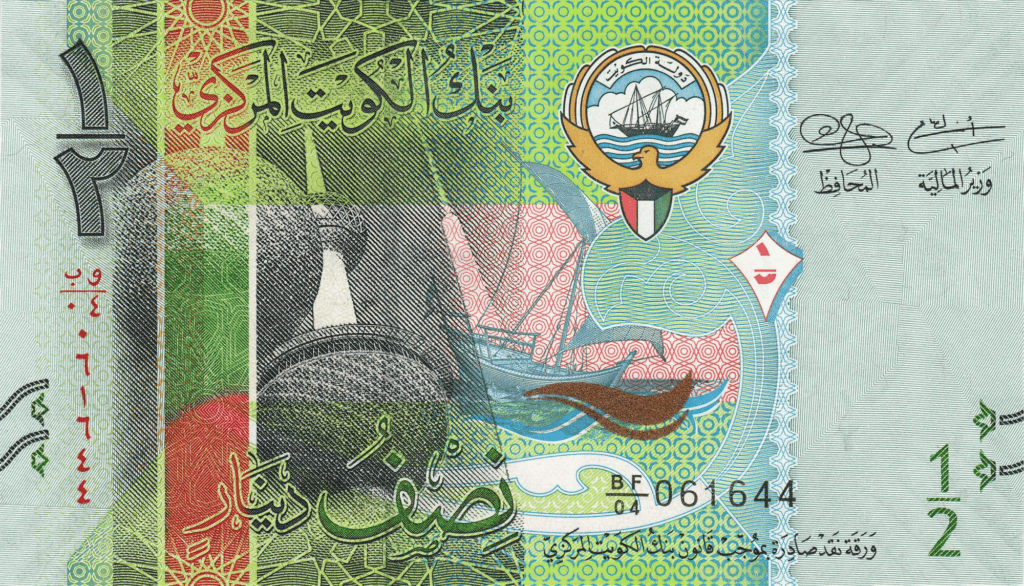
The KD 1⁄2 note, in green, shows the Kuwait Towers and a dhow ship on the front, and a Hawksbill sea turtle and the silver Pomfret fish on the reverse.
KD 1
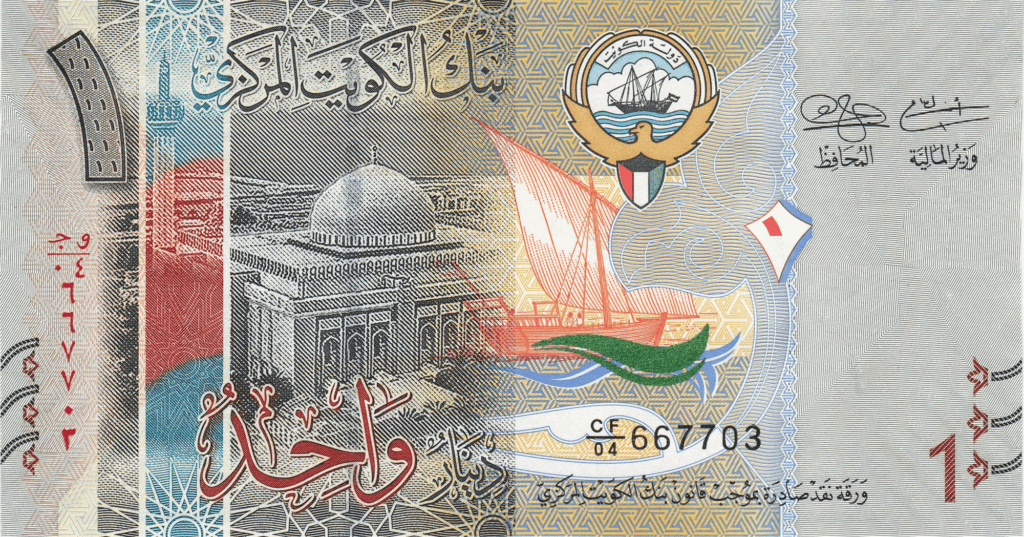
The grey KD 1 note illustrates the Grand Mosque and a bateel dhow ship, with the reverse featuring influences of Ancient Greek Civilization on Failaka Island.
KD 5
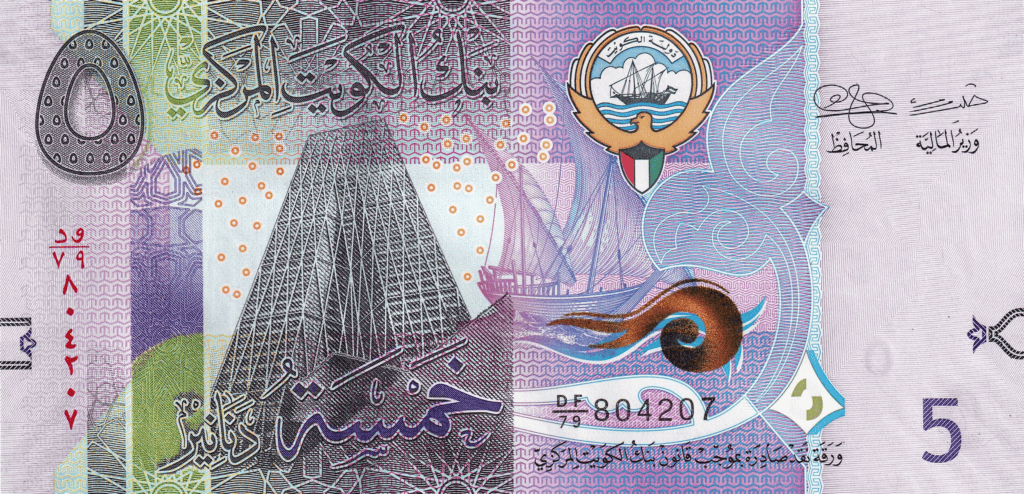
The purple KD 5 note has the new headquarters of the Central Bank of Kuwait and an oil refinery and tanker.
KD 10
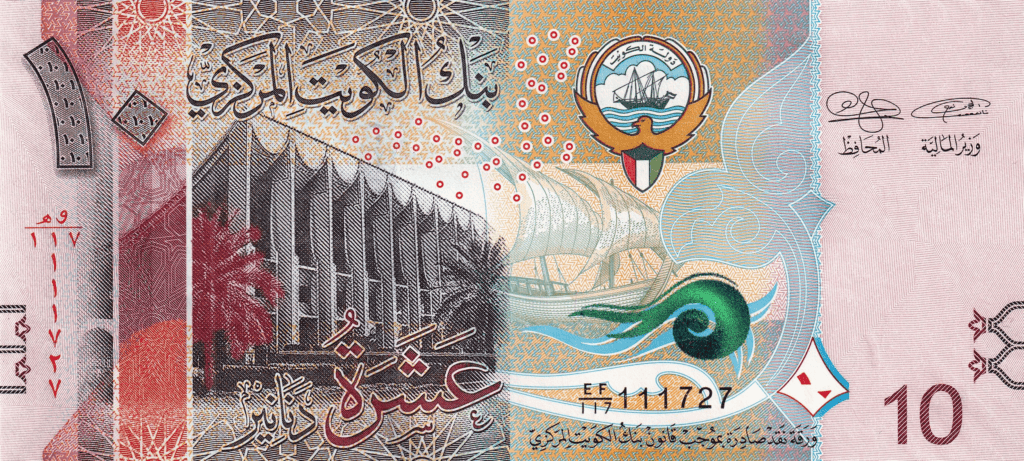
The pink KD 10 note displays the National Assembly of Kuwait and a sambuk dhow ship, with a falcon and camel on the back.
KD 20

The blue KD 20 note features the Seif Palace and a dhow ship, with a Kuwaiti pearl diver and the Al-Boom traditional dhow ship on the reverse.
Currency Usage in Kuwait
In Kuwait, the primary currency used is the Kuwaiti dinar (KWD), essential for both physical and digital transactions. While some tourist areas might accept limited foreign currencies, the dinar is predominantly used in daily life.
Cash is widely preferred for everyday purchases like groceries and transportation, but the use of debit and credit cards is increasing, especially for online shopping and larger expenses. Bargaining is not a common practice in Kuwait, with prices generally fixed and displayed in dinars.
For specific transactions, such as in restaurants and services, tipping is appreciated but not obligatory. Rent and property transactions are conducted strictly in dinars.
Public transportation fares are typically paid in cash or via transit cards, and mobile payment apps like Knet and Fawasir are becoming popular for contactless payments and transfers.
Foreign currencies can be exchanged at designated bureaus in airports and cities, but exchanging outside these authorized outlets is illegal. The Kuwaiti dinar is one of the world’s strongest currencies, reflecting the country’s high standard of living, though the economy is heavily dependent on oil.
Is USD accepted in Kuwait?
Although the official currency of Kuwait is the Kuwaiti dinar, US dollars are widely accepted in Kuwait. However, it is advisable to carry Kuwaiti dinars as it is the official currency and is accepted everywhere. You can exchange your US dollars for Kuwaiti dinars at any of the banks or exchange bureaus in Kuwait.
It is important to note that while some businesses in Kuwait may accept US dollars, they may not offer the most favorable exchange rates. Therefore, it is recommended to carry Kuwaiti dinars while traveling in Kuwait.
In addition to Kuwaiti dinars and US dollars, other major currencies such as the euro, British pound, and Japanese yen can also be exchanged in Kuwait.
Overall, it is advisable to carry Kuwaiti dinars while traveling in Kuwait to avoid any inconvenience. However, US dollars and other major currencies can be exchanged at banks and exchange bureaus in Kuwait.
Exchanging Currency in Kuwait
Exchanging currency in Kuwait is straightforward with several options available. The Kuwaiti dinar (KWD) is widely used for all transactions.
Authorized exchange bureaus like Al Mulla Exchange, BEC, and Al Ansari Exchange are reliable and offer competitive rates. They’re prevalent across Kuwait and are known for their professional services.
Major banks in Kuwait also provide currency exchange services, but their rates may not be as competitive. However, only a few ATMs dispense foreign currencies, like USD and EUR, and might charge higher fees and offer less favorable exchange rates.
Online platforms for currency exchange, such as X-Rate and TransferWise, are emerging, but it’s important to research their fees and reputation.
By choosing reputable exchange services and planning, you can ensure a secure and efficient currency exchange process in Kuwait.
Where can I exchange Kuwait currency?
If you’re planning to travel to Kuwait, it’s important to know where you can exchange your currency. You can exchange your money at banks, exchange offices, and hotels throughout the country.
You can also withdraw money from ATMs using your debit or credit card. Keep in mind that some ATMs may charge fees for international transactions, so be sure to check with your bank before you go.
What to know before exchanging currency in Kuwait
Before you exchange your currency, it is important to be aware of the exchange rate. The exchange rate is the value of one currency compared to another. You can check the current exchange rate online or at a currency exchange office.
Some key tips for currency exchange in Kuwait include carrying your passport for transactions over KWD 3,000, comparing rates at different bureaus, and avoiding illegal currency exchange to prevent fines.
Traveler’s checks can be a safe option for carrying large amounts, although they’re less common. The Central Bank of Kuwait publishes official exchange rates, and most bureaus operate during regular banking hours.
It is also important to know that some currency exchange offices may charge a commission or fee for exchanging currency. Be sure to ask about any fees before you exchange your currency.
Finally, be sure to count your money before leaving the exchange office. Make sure you receive the correct amount of money and that it is in good condition.
By following these tips, you can exchange your currency with confidence and ease in Kuwait.
Choosing Between USD and Kuwait Currency
When traveling to Kuwait, you will need to decide whether to exchange your US dollars (USD) for Kuwaiti dinars (KWD) or use your credit card for transactions. Here are some factors to consider when choosing between USD and Kuwait currency.
Exchange Rate
The exchange rate between USD and KWD fluctuates daily. You can use a currency converter, such as Xe, to check the current rate. Keep in mind that the exchange rate you get at a currency exchange booth or bank may be slightly different due to fees and commissions.
Convenience
Using USD in Kuwait may be convenient if you are only planning to make small purchases or visit tourist areas. However, if you plan to travel to other parts of Kuwait or make large purchases, you may need to exchange your USD for KWD. Some merchants may also prefer KWD over USD, and you may get a better deal if you pay in KWD.
Fees
Exchanging USD for KWD may come with fees and commissions. The fees and commissions may vary depending on where you exchange your currency.
Banks and currency exchange booths may charge a higher fee than credit card companies. When using your credit card, you may also incur foreign transaction fees, which can add up quickly. Check with your bank or credit card company to find out what fees you can expect.
Tips
Before traveling to Kuwait, check the exchange rate to understand the value of your USD in KWD. It’s advisable to exchange a small amount of USD for KWD at the airport or your hotel for immediate expenses.
For larger purchases or cash withdrawals, using a credit card is convenient, but try to avoid it for smaller transactions to dodge foreign transaction fees. Always compare exchange rates and fees at various currency exchange booths and banks to ensure you get the best deal.
Cost of Living in Kuwait
If you are planning to move to Kuwait, it is important to understand the cost of living in the country.
According to Numbeo, a single person’s estimated monthly costs are $772.30 (237.3 KWD) without rent. The cost of living in Kuwait is, on average, 42.2% lower than in the United States. Rent in Kuwait is, on average, 47.5% lower than in the United States.
The cost of living in Kuwait varies depending on the lifestyle you choose to lead. If you are looking to save money, you can choose to live in the suburbs or outside of the city center.
Food prices in Kuwait are generally affordable, and you can find a variety of options ranging from local street food to international cuisine. However, alcohol and tobacco products are expensive due to the high taxes imposed on them.
In addition to housing, food, and transportation costs, healthcare is also a significant expense in Kuwait. The country has a public healthcare system that provides basic services for free, but many people choose to pay for private healthcare to receive better quality care.
Overall, the cost of living in Kuwait is relatively high compared to other countries in the region. However, the country also offers high salaries and tax-free income for expats, making it an attractive destination for many.
Don’t Get Scammed Tips
When dealing with money, it is important to be vigilant and aware of potential scams. Here are some tips to avoid getting scammed when dealing with Kuwait currency:
1. Verify the authenticity of bills
Always check the authenticity of bills before accepting them. Kuwaiti dinars have several security features, including a watermark, security thread, and raised print. Familiarize yourself with these features to avoid accepting fake bills.
2. Use reputable exchange services
When exchanging money, use reputable exchange services such as banks or licensed money exchange companies. Avoid exchanging money with individuals on the street or through unlicensed services, as they may offer fake or counterfeit bills.
3. Be cautious with online transactions
When making online transactions, be cautious and only use reputable websites. Avoid clicking on suspicious links or downloading unknown software, as they may contain malware or viruses that can compromise your personal information.
4. Protect your personal information
Be wary of individuals or websites that ask for your personal information, such as your bank account or credit card details. Only provide this information to trusted sources and always verify the authenticity of the website or individual before sharing any sensitive information.
By following these tips, you can protect yourself from potential scams when dealing with Kuwait currency. Stay vigilant and always verify the authenticity of bills and sources before making any transactions.

